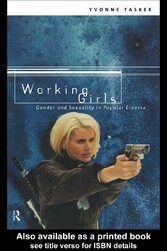
Working Girls - Gender and sexuality in popular cinema

von: Yvonne Tasker
Routledge, 1998
ISBN: 9780203746394
Sprache: Englisch
245 Seiten, Download: 4199 KB
Format: PDF, auch als Online-Lesen
6 FEMALE FRIENDSHIP (p. 137-138)
Melodrama, romance, feminism
I'am not going over a cliff for you two—so just forget it’, announces Jane DeLuca (Whoopi Goldberg) as the three stars of Boys on the Side (1995) make their getaway from Holly’s (Drew Barrymore) violent boyfriend Nick. The joke reference to the ending of Thelma and Louise foregrounds the movie’s location in relation to a narrative trajectory of escape from domestic restrictions and a repertoire of images of female bonding and transformation. A buddy/romance which rehearses the attraction of (same-sex) opposites, the movie follows musician Jane falling for ‘the whitest woman on the face of the planet’, Robin (Mary Louise Parker).
En route to California they ‘rescue’ Holly from an abusive relationship, though they cannot save her from falling for an Arizona cop named Abe Lincoln (Matthew McConaughey). If the inadvertent death of a violent man and the lovesick pursuit of a cop invert the images of flight showcased in Scott’s film, in which a uniformed police officer is the focus of first fear and then ridicule, and in which Louise quite consciously chooses to kill Thelma’s assailant, the two movies nonetheless draw on shared generic terrain. In its montage sequences, in settings such as the shared house in the desert and the Country and Western bar in Tucson, in its scenes of intense emotion between women, generational conflict, and the awkward negotiations around desire between the two straight women and a lesbian given to crushes on (seemingly) unattainable heterosexual objects of desire, Boys on the Side also rearticulates a familiar set of movie themes concerning female companionship.
Across the majority of its genres, the popular American cinema has marginalised representations of female friendship, more often favouring glamorous stars seen to exist in spectacular isolation, supportive figures who exist almost exclusively in relation to the hero, or women set in competition with each other. The seemingly nostalgic appeal of noir imagery, discussed in relation to contemporary discourses of women, work and sexuality in Chapter five, is pertinent once more here. In Klute, a movie that invokes lesbianism at its margins, Bree Daniels is isolated from other women, she is one of several in a militarised line-up in an early ‘audition’, but rarely does she speak to the other women.1 The femme fatale is almost by definition opposed to other female characters, though in Rafelson’s Black Widow the structuring tension of attraction/repulsion between her and the investigator is that between two women.
In both Fatal Attraction and Presumed Innocent women are pitted against each other, so that in Amelia Jones’ words they ‘work to destroy each other’ (1991:312). Bound, with its lesbian partners-in-crime protagonists, stands as almost the only new film noir not to represent women in terms of contrast and conflict. Similarly, with the exception of the mythicised Western setting, parodied in Even Cowgirls Get the Blues and exploited in Bad Girls, relationships between women have only rarely provided the central dynamic of recent action-based narratives.







